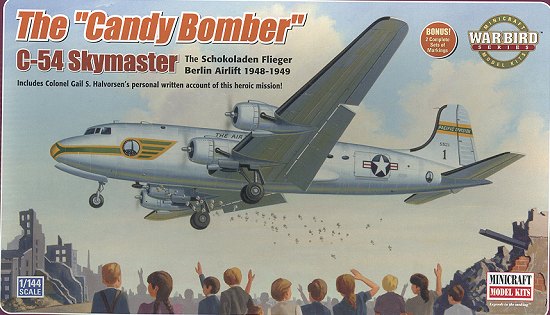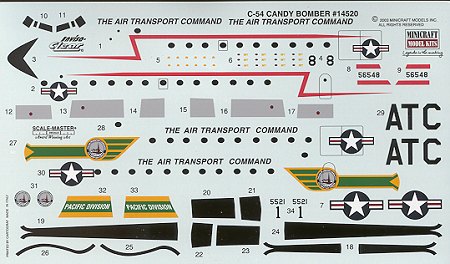
| KIT: | Minicraft 1/144 C-54 Skymaster "Candy Bomber" |
| KIT #: | 14520 |
| PRICE: | $22.00 MSRP |
| DECALS: | Two options |
| REVIEWER: | Scott Van Aken |
| NOTES: |

| HISTORY |
The C-54 was a military development of the DC-4 four-engine airliner, an aircraft designed for long range flights both within the US and overseas. These were to take the place of the flying boat. With the start of WWII, those DC-4s on the production line were converted to cargo/transport aircraft and given the military designation of C-54. They flew countless missions delivering high priority cargo and thanks to their carrying capability and long range were perfect for the Pacific Theater, where most of them were used.
Hundreds were on hand at the end of the war and so were on hand when the Russians closed all ground access to Berlin and so they were the major aircraft used during the Berlin Airlift of 1948. The most memorable use of the C-54 was as a 'Candy Bomber' and allow me to quote from the instruction sheet for the rest of this.
"1st Lt Gail Haverson was a USAF pilot flying C-54s into Berlin. He had seen a crowd of children along the end of the flying field in Berlin, watching the planes. He told the children to watch for his plane the next day, he would wiggle his wings and drop them a surprise.
The next day, as Haverson flew over the kids at the end of the runway, he wiggled his wings then, using the flare chute, dropped small parachutes made from handkerchiefs, each with a chocolate candy bar attached. Soon, more children began to appear, waiting expectantly for the candy.
By the time the military command heard about the 'candy bomber', it was so successful and popular with the air crews, that despite their official displeasure, they recognized the morale value of it and Operation Little Vittles was officially formed.
Parachutes were made by the crews and their families, handkerchiefs were donated and even made from actual parachutes. Candy manufacturers donated chocolates and 23 tons of candy was collected by school children in Massachusettes. These were flown to Westover AFB and then to Rhein-Main in Germany. Naturally, the military made regulations for the parachutes. They were to be 15 inches square and attached to each candy bar by four pieces of string, each 16 inches long. Each parachute had a note requesting its return to an MP for reuse.
While there was no one aircraft designated as 'candy bomber', but C-54 serial 45-6548 was one of the aircraft flown by Lt Halvorsen during the candy drops.
| THE KIT |
There is absolutely no difference in this kit and the DC-4 kit previously previewed other than the color of the plastic (this one being silver). So to save time and space, here is what I said about that kit. The kit bits pic is of the DC-4.
 Like many airliner enthusiasts, I have been awaiting a decent DC-4/C-54 for quite some time. I just like propliners and this was one of the best. Minicraft have basically taken over the airliner market with their many different aircraft kits. Some have been lambasted for inaccuracies here and there, but since I'm not an expert on these planes, they have all looked pretty good to me. This particular kit is molded in white plastic and has engraved detailing that is really way over scale, but it is what is expected from kits nowadays.
Like many airliner enthusiasts, I have been awaiting a decent DC-4/C-54 for quite some time. I just like propliners and this was one of the best. Minicraft have basically taken over the airliner market with their many different aircraft kits. Some have been lambasted for inaccuracies here and there, but since I'm not an expert on these planes, they have all looked pretty good to me. This particular kit is molded in white plastic and has engraved detailing that is really way over scale, but it is what is expected from kits nowadays.
There is no interior at all, which is not unexpected as many airliner kit builders would rather use decals to represent the windows in this scale anyway. The cockpit section is clear plastic and includes the surrounding sheet metal so that fairing it in place is simple. Frankly, since they kit comes with cockpit window decals, I wonder why they bothered with the clear parts. It would make molding much easier to just include those parts in the fuselage halves.
All these tricycle landing gear propliners are going to be tail heavy so you'll need nose weight. The instructions recommend 3/4 ounce. Minicraft have molded the nose gear a bit more sturdily than the prototype would have been and that is good. I've built the Heller DC-6 and broken the nose gear a number of times. T his thicker nose gear will help keep it intact. No wheel well detail is provided and the engines are just representations, but in this scale, that is more than adequate.
his thicker nose gear will help keep it intact. No wheel well detail is provided and the engines are just representations, but in this scale, that is more than adequate.
There are nine construction steps, each of which really has minimal parts so that it seems to build rather quickly. Color information is provided in each of the construction steps as needed. A nice addition is that all the parts are named. There is also a parts diagram to help find those bits needed. Decals are provided for two planes. Both are in bare metal with black de-icer boots on the wings. Thankfully, these de-icer boots are provided as decals as are the grey areas for the wing walks. The two planes differ in their markings. One is the box art plane from the Pacific Division of the Air Transport Command. The other is one of the planes flown by Lt. Halverson with a large red lightning bolt on the side. The decals themselves are superbly printed by Cartograf.
| CONCLUSIONS |
I'm sure that this kit will do well with those who like transports. I like the fact that I can do a large four-engine transport without having to build a new addition to the house to hold it!
You can thank me for purchasing this kit for your review enjoyment!
Postscript: As sometimes happens once I havebuilt the kit, I received an e-mail from a knowledgeable reader who states that the green in the second scheme actually should probably be blue as he's never seen any similar aircraft in yellow and green, but in yellow and blue.
If you would like your product reviewed fairly and quickly by asite that has over 250,000 visitors a month, please contactme or see other details in the